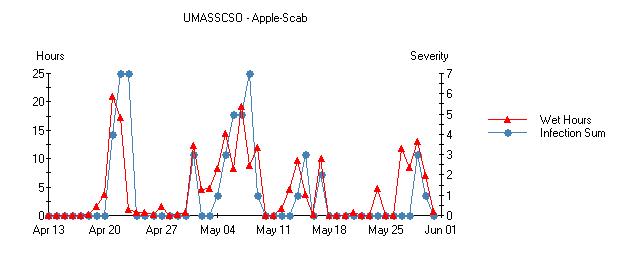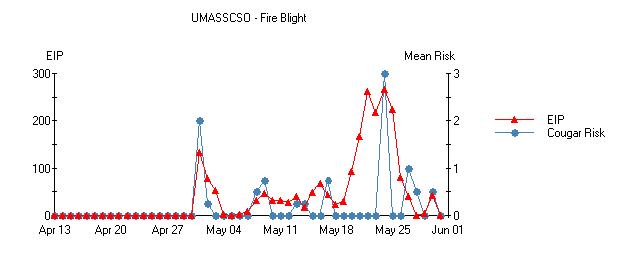Contents
-
Current degree day (DD) accumulations
-
Upcoming meetings
The way I see it
- IFTA sets sail to Nova Scotia
- Apple scab and fire blight wrap-up for 2009
- Plum curculio season not over until it's over
- Rescue thinning and enhancing return bloom fact sheets
- Guest article: Calcium Sprays on Apple Prevent Cork Spot and Bitter Pit
Current (through June 1) degree day (DD) accumulations
Location: UMass Cold Spring Orchard (CSO), Belchertown, MA
Base 43: 806
Base 50: 456
Plum curculio model: 216 (Base 50 from petal-fall, 05-11-09; 308 is the 'end')
Significant upcoming orchard events based on degree days (Base 43):
codling moth first flight peak: 593–1017
obliquebanded leafroller pupae present: 601–821
European red mite summer eggs hatch: 737–923
spotted tentiform leafminer 1st flight subsides: 666–944
pear psylla summer adults present: 737–885
Upcoming meetings
June 16 and 18, 2009: Tree fruit twilight meetings
June 16, 5:30 PM: Clarkdale Fruit Farms, Deerfield, MA
June 18, TBA
July 15, 2009: Massachusetts Fruit Growers' Association Summer Meeting, Tougas Family Farm, Northboro, MA
August 2–5, 2009: International Fruit Tree Association Annual Short Orchard Tour, Nova Scotia, CANADA
December 15-17, 2009: New England Vegetable & Fruit Conference, Manchester, NH
The way I see it
No one can say it has been too warm, hence, various aspects of fruit/disease/insect development are kind of 'stagnant.' I hate to say it, but we could use some warm, sunny weather. (Now it's going to get hot for sure since I said it.) What I am seeing lately: some apple scab; summer generation of mites; peaches and cherries waiting for some better weather; and apples with Golden Delicious background (i.e. Gala) that still need some serious thinning. I have yet to see: plum curculio injury (but I have not looked at any unsprayed trees); oblique-banded leafoller; and apple scab where kickback fungicides were used. Now is the time to start paying real good attention to the fruit and foliage to detect any serious presence of disease (scab) or insect injury, so that you can 'head it off at the pass.'
J. Clements
IFTA sets sail to Nova Scotia
The International Fruit Tree Association's (IFTA) Annual Short Orchard Tour is August 2–5 in Nova Scotia, CANADA. From the IFTA website, "Nova Scotia is once again pleased to host a visit by IFTA. Headquarters for the tour will be the Old Orchard Inn in Wolfville. The orchard tour will be centered in the Annapolis Valley, an area ranging from 2 to 10 miles wide and 80 miles long. The majority of Nova Scotia's apple production is located within 25 miles of Kentville, which is at the eastern end of the valley. We will also be traveling to historic seaport of Halifax, noted as being one of the most scenic cities in North America, and the bustling fishing town of Digby."
This is a reasonable trip for many of us, and I encourage you to go. There is ferry service from Portland to Yarmouth, and that saves a long drive. More information and registration details are the IFTA website, http://www.ifruittree.org/.
J. Clements
Apple scab and fire blight wrap-up for 2009
Most of us are at the end of primary apple scab season, and unless you have scab in the orchard now -- you gotta look -- you should be done spraying for this disease. Overall, it seemed like a pretty 'easy' scab season, however, there are some reports of scab filtering in, and I expect it was a result of insufficient fungicide coverage during a prolonged wetting period from May 4–9. (See chart below.) If you are seeing scab, there is an excellent article 'Dealing with Secondary Apple Scab' by Dave Rosenberger in this week's (June 1, 2009) Scaffolds Fruit Journal.

I want to say we largely missed the fire blight bullet too, however, I'd like to hear from anyone who may be seeing fire blight now. I expect some strep went on during the period around May 9 when many orchards were in bloom, however, at least in Belchertown there was no strep applied as the risk of infection never really ramped up. (See chart below.) And there is no fire blight (so far). Strep was applied to a block of cider apples that were in bloom app. May 23 when the risk was very high. Fire blight is a very fickle yet potentially explosive disease. Again, I would like to hear from anyone who sees any blossom or shoot blight this year.

J. Clements
Plum curculio season not over until it's over
As noted above, we have accumulated about 2/3 of the Degree Days to deem plum curculio season 'over.' We are probably over the hump, but there is still some risk of injury so waning insecticide coverage should be renewed for another week to ten days.
J. Clements
Rescue thinning and enhancing return bloom fact sheets
Timely and updated fact sheets available on the UMass Fruit Advisor website:
F-129R--2009 Late Season "Rescue" Thinning with Ethephon
Summary recommendation for "rescue" thinning with ethephon:
- Treat when temperatures are 70-80 F (day of treatment + 2 days).
- Do not treat when below 70 F or above 80 F (day of treatment + 2 days)
- Fruit 15-25 mm diameter (0.8-1 inch)
- McIntosh and Macoun 200-300 ppm (0.7 - 1 pint Ethrel per 100 gallons dilute spray, with 0.5 lbs carbaryl a.i. and a surfactant)
- See the fact sheet noted above for more precautions and details
F-131--2007 Enhancing Return Bloom on Apple with Plant Growth Regulators
Summary recommendation for enhancing return bloom with ethephon
- Begin 4 to 6 weeks after full bloom and after 'June drop'
- Use Ethrel at 0.5 pint per 100 gallons dilute spray -- can be combined with cover sprays
- Make 2 to 3 weekly applications depending on variety (1-2 on early maturing cultivars)
- Avoid applying at high temperatures and/or too early as ethephon can cause significant fruit thinning under the right conditions
- See the fact sheet noted above for more precautions and details
J. Clements
Guest Article: Calcium Sprays on Apple Prevent Cork Spot and Bitter Pit
by Win Cowgill, County Agricultural Agent, Rutgers Cooperative Extensionreprinted from Rutgers Cooperative Extension Plant & Pest Advisory, Fruit Edition, June 2, 2009
Editors note: you may also want to see the fact sheet F-119R Foliar Calcium Sprays for Apples on the UMass Fruit Advisor. J. Clements
First cover is the time to begin calcium sprays.
Calcium (Ca) is the key – the quickest and most effective short-term corrective treatments for control of bitter pit and cork spot in apple are to add a readily available source of calcium to your cover sprays.
To control cork spot in apple flesh spray trees with 1.5 pounds of calcium chloride (CaCl2) or 3.2 pounds of calcium nitrate (CaNO3) per 100 gallons of water with first cover spray and include in each subsequent cover spray until a total of 18 to 24 pounds per acre has been applied. The calcium nitrate sprays will apply 2 to 3 pounds of actual nitrogen (N) per acre and should be used only on trees that do not contain high to excessive nitrogen levels as measured by leaf analysis or reflected in excessive shoot growth.
To control bitter pit, spray trees with a solution of either calcium chloride or calcium nitrate. Use 2 pounds of calcium chloride or 4.25 pounds of calcium nitrate per 100 gallons of water plus a wetting agent. Calcium nitrate should not be used on trees that contain high to excessive amounts of nitrogen in the leaf tissue as measured by leaf analysis or that are making excessive shoot growth. Make applications at 2-week intervals with the last spray 2 weeks before harvest. These calcium sprays can reduce bitter pit in apples by 50 to 90 percent.
For Calcium sensitive varieties such as Enterprise, Braeburn, Fuji, York, Cortland and Honeycrisp, apply calcium chloride (CaCl2) at a rate of 2-3 lb/100 prior to August 1, then 3-5 lb/100 after August 1.
Late season calcium sprays are usually more effective against cork than early season sprays.
Reduced rates of calcium chloride should be applied if there was no rain between applications, or if it is very hot and humid.
Form of Calcium for Foliar Spays
There are many calcium products promoted
by industry as substitutes for calcium chloride. Extensive
research and comparison of these products, however, has yet to show an
advantage over calcium chloride because it is one of the richest forms
of calcium at the cheapest price. Calcium nitrate (CaNO3) can be substituted
for CaCl2 but only on trees that do not contain low nitrogen levels as
measured by leaf analysis. Vigorous trees should not receive Calcium nitrate.
Growers opting to use CaNO3 as their calcium source should be aware that
CaNO3 does not contain as much available calcium as CaCl2, so they should
adjust their rates accordingly.
